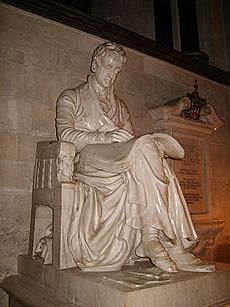Sir Richard Hoare, 2nd Baronet facts for kids
Sir Richard Colt Hoare, 2nd Baronet (born December 9, 1758 – died May 19, 1838) was an English antiquarian and archaeologist. He was also an artist and a traveler. Sir Richard was very important for studying the history of his home county, Wiltshire, in great detail.
Contents
Sir Richard's Life and Work
Sir Richard Colt Hoare was born in Barnes, Surrey. His family was well-known for their banking business, Hoare's Bank. His great-grandfather, Sir Richard Hoare, started the bank.
Early Life and Family
Sir Richard went to school in Wandsworth and Greenford. He learned about classic subjects like ancient Greek and Roman studies.
In 1783, he married Hester Lyttelton. Two years later, in 1785, he inherited a large estate called Stourhead in Wiltshire. This inheritance allowed him to follow his interests, especially archaeology. His grandfather wanted him to leave the banking business. This was to make sure the estate would be safe if the bank ever had problems.
Travels and Discoveries
Sadly, in 1785, Sir Richard's wife and their second child died. After this loss, he traveled a lot. He went on a "Grand Tour" through France, Italy, and Switzerland. During his travels, he made many sketches. These sketches later became beautiful drawings and watercolors.
In 1786, he bought Glastonbury Tor. He also paid to fix the church tower on it. He became a baronet in 1787. A year later, he went on another trip to Europe. He wrote books about his travels, like Recollections Abroad and A Classical Tour through Italy and Sicily.
He also traveled through Wales. He translated old Welsh writings by Gerald of Wales. These works were called Itinerarium Cambriae and Descriptio Cambriae. Sir Richard added his own notes and a story about Gerald's life. He also published a book about his trip to Ireland in 1807.
Sir Richard was chosen to be a member of the Royal Society in 1792. He was also a member of the Society of Antiquaries of London. In 1805, he became the High Sheriff of Wiltshire. He loved collecting plants, especially Pelargoniums and Rhododendrons.

Later Life and Passing
Sir Richard Colt Hoare passed away at Stourhead in 1838. His burial place is in the churchyard of St Peter's in Stourton, Wiltshire. It has a special Gothic monument designed by John Pinch the Elder.
Amazing Archaeology Work
Sir Richard Colt Hoare made big contributions to archaeology. He worked with William Cunnington to dig at Stonehenge in 1798 and 1810. They dug around fallen stones and found that they used to stand upright.
Exploring Ancient Burial Mounds
Sir Richard also dug into 379 ancient burial mounds, called barrows, on Salisbury Plain. He found and recorded many other old sites in the area. He wrote down and sorted all his findings.
At that time, people didn't have the "three-age system" yet. This system helps archaeologists figure out how old things are (like Stone Age, Bronze Age, Iron Age). Because of this, Sir Richard couldn't tell the exact age of his discoveries. This made it harder to understand them fully.
Important Books on History
His most important book was The Ancient History of Wiltshire. This book shared all his findings. It was first published in parts from 1810 to 1821. He also helped a lot with another big work called The History of Modern Wiltshire. This was a collection of 11 volumes published between 1822 and 1844.


